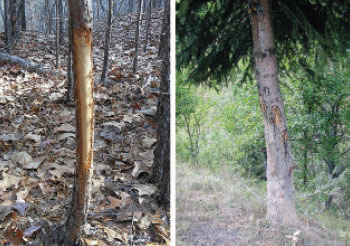
Identifying Unwanted Wildlife in the Landscape
by Lynn Barber / Published July 2014

Most of us enjoy attracting wildlife to our landscapes. However, there are some wildlife species we would prefer take up residence elsewhere. Nuisance wildlife are able to damage our turfgrass, landscape beds, and vegetable gardens. The first step in managing nuisance wildlife is to identify which wildlife species is causing the damage we are experiencing. There are several ways we can make this identification as these unwanted interlopers cause specific problems. The damages include soil disturbances, bark damage, vegetation consumption, pilfering in vegetable gardens, and leaving evidence behind in the way of animal tracks and scat.
SOIL DISTURBANCES
We will start with soil disturbances. The size, location, and shape of the holes will help you identify the culprit. Small holes can be created by chipmunks, voles, Norway rats, or snakes. Holes that are 6–12 inches in diameter can be created by red foxes, skunks, armadillos, or coyotes, and these are usually at the base of trees, logs, or walls. This size of hole with a mound of sandy soil at the entrance is generally created by a gopher tortoise where they seek shelter. Tunnels that are 6–12 inches below the ground can be created by pocket gophers. While you won’t see an entrance hole, you will see a mound of soil in asymmetrical, crescent-shaped piles. Moles make underground tunnels and consume soil insects. Their feeding tunnels are just below the soil surface, so you will see raised ridges and soil in small, symmetrical, volcano-shaped mounds with an exit hole in the middle. You may also experience damage from armadillos, shallow holes one to two inches wide and one to six inches deep. Wild hogs cause significant damage as they root in soil and wallow in wet areas creating significant disturbances.
 BARK DAMAGE
BARK DAMAGE
Bark damage can be caused by gray squirrels, deer, black bears, wild hogs, and woodpeckers. Gray squirrels remove large patches of bark from higher tree branches. Male deer rub against bark removing one side of it. Black bears strip the bark, feed on the inner bark, and mark their territory with the damage. They also scar trees with their claws when climbing. Wild hogs rub against the trees, leaving mud and coarse hair on that area. Woodpeckers can drill holes in live trees to secure food, tree sap, and insects.
VEGETATION CONSUMPTION
Vegetation clipping can be caused by rabbits, deer, and beaver. Rabbits have sharp teeth and make clean cuts at low-to-the-ground levels. White-tailed deer rip vegetation (no upper incisors), which leaves a jagged look at a higher level. Beavers cut shoots, saplings, or trees off at the base near water bodies, two feet from the ground. Their cuttings leave a tapered point in the middle.
VEGETABLE GARDEN PILFERING
Vegetable garden pilfering can be challenging. Raccoons love watermelons and dig a small hole in the side, raking out contents. Coyotes take small bites out of the side and eat the center. Deer and hogs paw the melon to break it open and eat the contents. Deer are fond of young peanuts and soybeans.
ANIMAL TRACKS AND SCAT
Animal tracks and scat can be identified by the droppings they leave behind. The size, shape, and color assist in determining the nuisance. Scat the size of rice grains is probably from rats, mice, chipmunks, or bats. If the scat is round, pea-sized, and rough, it’s probably from a rabbit. Oval pellets can be from squirrels, while slightly larger, oval, and smoother scat can be from white-tailed deer. Fox and coyote droppings are usually two inches long and one-half inch in diameter, segmented with pointed ends, containing hair, and possible bone. Bobcat scat is generally four inches long and segmented with blunt ends. Raccoon droppings have one inch uniform thickness and blunt ends. Wild hog scat depends on what is consumed, but it generally looks like dog feces. You can take a photo of the scat if you want to compare it with wildlife management field guides at the Internet Center for Wildlife Damage Management at icwdm.org/Inspection/Scat.aspx or North Woods field guides www.northwoodsguides.com/animal_scat_notes.htm. If you want to determine whose tracks you have found, visit the Purdue University Extension at www.ag.purdue.edu/entm/wildlifehotline/pages/TrackID.aspx.
For more information on wildlife identification, and from which the contents in this article were taken, please view the University of Florida publication, “How to Identify the Wildlife Species Responsible for Damage in Your Yard”, by Holly K. Ober and Arlo Kane, at edis.ifas.ufl.edu/pdffiles/UW/UW36900.pdf.
As always, follow the landscape or architectural control procedures in your deed restrictions before making changes. For more information about the nine principles of the Florida-Friendly LandscapingTM Program or for assistance with gardening related questions, contact your local county UF/IFAS Extension and/or visit the University of Florida websites solutionsforyourlife.com and edis.ifas.ufl.edu.

